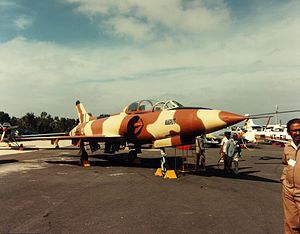From wretched fettle to journey to the skies: LCA Tejas
It was 1960s when Indian Government hit with the notion of developing an indigenous aircraft, primarily, a light combat aircraft in nature. After a year of formalities, the idea started on paper. Indians had already been in sound relationship with Germany who came to aid to develop a conventional delta wing air frame which later was powered by Orpheus engine. Marut did its first flight in 1961 and got inducted in 1965. The airframe was ready to go to Mach 2 but failure to acquire enough powerful engine never realized its true potential. In 1974, India tested its first nuclear weapon in Pokhran. And subsequent prohibitions barred India from acquiring new powerful engines. And the journey for Marut ended in 1985.
 |
HF 24 Marut |
Then came the era when the MiG-21 Bison, known as Flying Coffins started crashing and India had the second largest inventory of the aircraft. India laid down a plan to meet its requirement to medium range light aircraft that can match extreme conditions for Indian terrains spanning over from Himalayan to Thar desert. Self-reliance was another attribute Indians wanted to earn.
LCA airframe finalised in 1990 as a tail-less delta winged
machine with relaxed static stability (RSS) to enhance maneuverability
performance and a host of other advanced features. In 1989, Review committee that Indian infrastructure,
facilities and technology had advanced sufficiently in most areas to
undertake the project. It was decided that the full-scale engineering
development (FSED) stage of the programme would proceed in two stages.
LCA Tejas |
At initial scale, proof of concept took more focus than the aircraft as a whole. This was going to be costlier mistake for the program. Prototypes were worked on GE's engines whereas whereas Kaveri engine's development was going through rough stages.Then in 1999, India tested five nuclear bombs and further sanctioned were imposed. It eventuated in cease of UK and French aids in building Kaveri engines. Without engine, the aircraft is nothing more than a toy. The program faced extreme delays and the cost started escalating in multi-folds. Estimated project cost $85 million reached to $2.6 billion and still it faced issues of quick obsoletion at the time of Final Operational Clearance (FOC) in 2011. Still naval LCA Tejas development was missing many critical aspects when pitted against MiG 29K which was chosen to operate on Admiral Gorshkov.
LCA Tejas in Bahrain Air Show
The CAG report further noted that due to the delay in the LCA program the IAF had to make temporary arrangements to upgrade its MiG fleet and revise its timeline for phasing out MiG-21 FL fighters. And it is the LCA program’s failure to address this issue that has brought the IAF to its knees. The Indian government first opted to purchase the Russian-made MiG-21s in 1961. Thereafter India introduced 872 MiG 21s into its air force, forming the backbone of its fleet. Having seen action in 1965, 1971 and 1999, many squadrons of this once venerable fighter have reached operational redundancy. However, the delay in the LCA program and possible vulnerabilities due to force accretion compelled the IAF to push back the phasing out of its MiG-21 fleet. The MiG-21s, which were upgraded to “Bison” standard in a last-ditch attempt to keep them in the air, are on “their last legs” warned Air Chief Arup Raha in 2014. |
Naval LCA Tejas MK-II |
References:
No comments :
Post a Comment